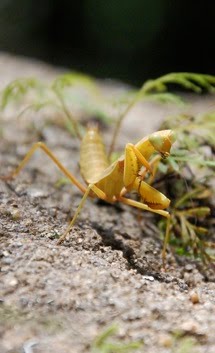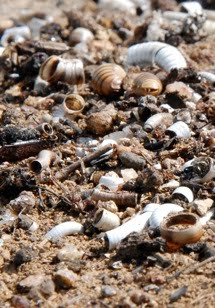This Little Piggy...
...went to market,
This little piggy went home,
This little piggy had roast beef,
This little piggy had none,
This little piggy had a tungiasis infestation from a burrowed sand flea
and went "Wee, wee, wee" all the way home.
This little piggy went home,
This little piggy had roast beef,
This little piggy had none,
This little piggy had a tungiasis infestation from a burrowed sand flea
and went "Wee, wee, wee" all the way home.
On the recent trip back stateside, my old students had lots of great questions about the people, places and customs of wild Madagascar...but mostly they just wanted to know about the creatures that had hatched out of my toe. Sadly, I didn't know exactly what they were. I know, what kind of science teacher am I anyway? Well, I can now proudly say that my little piggies had none other than sand fleas.

The flea in question: the sand flea.
[Photo taken from http://www.healthinplainenglish.com/health/infectious_diseases/tungiasis/index.htm]
I say piggies and not piggy, because just one day after I saw my students I awoke to a second lovely hatching. A little natural miracle right there under my right pointer toe. I thought I had a bit of black lint stuck under my toenail, but alas it was no bit of dress sock. It was Tunga penetrans aka chigoe flea, jigger, foot bug, sand flea or pico.
No matter what you call it, it is a parasite. They like to live in warm sandy soil like beaches. The mommy fleas like to attach themselves to a nice warm-blooded host like a cow, pig or me. They chew and digest their way through the outer layer of skin, but they don't crawl all the way in. Instead, they leave their little flea heinie (abdomen) sticking out. They use it like a snorkel to breath. It looks like a swollen bug bite with a black dot in the center. It doesn't hurt though, so most cows, pigs or, in this case, people don't notice when mommy moves in.

The black tubey thing is the flea's abdomen. The white eggy things are...uh, eggs.
[Photo taken from http://www.healthinplainenglish.com/health/infectious_diseases/tungiasis/index.htm]
In one or two weeks the female flea swells up to about the size of a pea with a 100 or so adorable little flea eggs. The eggs drop out of her heinie/abdomen/snorkel and fall to the ground. Then, sadly, the mommy dies and is eventually pushed out of the host's foot as it heals up. Meanwhile, the sweet eggs wiggle and hatch in about three or four days. They zip right through pre-school and the teenage years and in a mere two or three weeks they are crawling into feet of their own to lay eggs.
And since this whole life cycle rigamarole takes about a month and it has now been about a month since I've had any hatchings, I think I can safely say I am flea free. I do think I will be a bit more careful with my piggies next time I'm around warm, dry sandy soil though. I will be sure to wear my Scooby Doos.
(Oh, I may have forgotten to tell you that here they call flip-flops Scooby Doos. No, I have no clue why. And trust me, I've asked.)




My unlucky piggy. You can see the little black abdomen, but she did not get a chance to lay her eggs. There were eggs to be found, but they weren't quite ready for laying.
[The rest of the photos were taken by my slightly creeped out wife.]

A little cleaning and pruning with some toenail clippers to be sure all the wee beasties were gone and I was well under way to a flea free kind of life.

A little peroxide did the final cleaning. Don't worry, the bubbles are a good thing. It's the extra oxygen atom in peroxide (H2O2), being released when it hits the bloody and gooey bits of a wound. Oxygen may seem like a good thing, but too much at one time is poisonous to most germs.





12 comments:
Mr. Lebo,
Please, please wear shoes more often this year. That is easily the grossest thing I have ever seen.
Your friend and colleague,
Ms. Rabner
Capital idea. I don't go barefoot at all really unless I'm at the beach. Alas, that is where these beasties like to live.
Our dog got into the parasitic action too. A few weeks ago she came down with a spot of mange. Mange is an overinfestation of mites that cause skin irritation and hair loss. We all have them (and by we I mean dogs and humans), but if a body gets weak, they can reproduce and get out of control.
She spent a week at the vets and is doing just peachy now.
Thanks a ton for the comment.
Essence of years old birkenstocks & ducktape. This is perfect medium for a wonderfully original fellow.
Thanks for sharing.
-R. Winter
I preferred seeing the fake snow snowmen! Mr. Holsten
Mr. Lebo,
Why do lizard's tails grow back if they fall off, but our feet, toes, etc. don't grow back?
Alexandra Bell 5th
Why is lizard's blood blue or purple inside but red when it comes out?
Leila
fifth grade
Mr. Winter, thanks for checking in and thanks for remembering a well and long loved pair of shoes-my college sandals.
Where ever you ended up, I hope you are well.
Dear Mr. Holsten,
I love water I can safely drink and swim in, but we can't have everything now can we?
Dear Alex,
Fantastic question! You are right that some lizards can grow back their tails. All animals can regrow some parts. Your skin can grow back. Your broken bones can heal. But salamanders take the cake. They can regrow feet and legs too, or even a lung, or a hunk of their tiny brains. They can even regrow after breaking their spinal cords. No one is quite exactly sure how the little amphibians do it, but scientists do know that they they don't have super special cells that we don't. There is just something in their cells that remember what the missing cells used to be tell the new cells what to look like. Their cells aren't that different than ours. So who knows, maybe when you become a scientist you can figure out how to trick human cells into doing the same crazy things.
Dear Leila,
Pretty weird, huh? Blue on the inside and red on the outside. Well, it's a bit of a trick. But don't blame the lizards. We do the same trick. Look at your arm. See any blue blood running through your veins? Actually, you don't. You see dark red blood that only looks blue. Your eye can only see things when light bounces off of something first. When you look at your veins, or a lizard's, the light has to go through your skin, hit the veins that the blood is inside, go back through your skin and up to your eyeball. That takes a lot of energy. And only some of the wavelengths of light have the energy to do all that bouncing. Red poops out and gets stuck in your skin. But blue light has enough oomph to get through our skin and back out and up to your eye. That means that you see blue blood, when it's really red. If you get a cut and you can see the blood without having to peek through all that pesky skin, it always looks red.
Or course, horseshoe crabs actually do have blue blood, inside and out. But that's a longer story that we have time to tell right now.
Mr.Lebo,
Hello!!!This is Maddie and i wanted to say hi!!!Your toe infection looks gross, but now i now what to look out for!I agree with Ms.Rabner, please wear shoes!Kelsey Schwimmer wants to say hi to you.(You were her third grade teacher.)I really miss seing you, BYE!!!!
From Maddie Schwimmer
Mrs.Gargione's class
5 grade
Mr. Lebo,
You mentioned clean water. Have you ever used one of these or have you seen anyone using one in Madagascar? LifeStraw You can click on "how it works"--talk about an amazing use of science!
Mr. Holsten
I think you need to write a book:
"Parasites and other strange creatures I have met. For real."
Or would that tick you off? :)
Rimshot.
Post a Comment